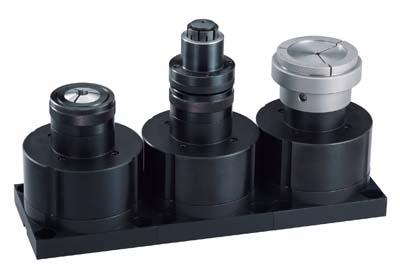
Parts remain clamped if loss of air occurs when using the Hardinge failsafe collet block (closer). Air is required during setup to receive the part, whether using a single collet block or a sub-plate of multiple blocks. After setup, a unique spring design holds the workpiece with 1,760 pounds of optimum 5C drawbar force. The spring-to-close design provides the opportunity to use pallet shuttles without the need for air or hydraulic lines. If loss of air should occur during the machining process, parts will remain clamped and concentricity will be maintained without downtime, waste or injury.
Modular units can be used vertically, horizontally or in any position for machining or assembly operations. These units will line up on a trunnion plate for fourth-axis, multiple-part machining with a rotary table. Each unit has a 5" square footprint with four mounting holes 4" on-center. A 1⁄8-27 NPT port is located on the back of the unit for connection to shop air. Maximum operating pressure is 75 psi. Multiple units will connect to a single pneumatic connection, but can have separate valves for controlled workpiece placement during setup. Custom sub-plates, modular setups, valve assemblies and special collets can be provided by Hardinge to meet individual requirements.
The Hardinge thru-hole base design allows coolant and chips to be flushed through, rather than building up. This eliminates the time-consuming process of tearing down and cleaning out the unit, as would be the case with other closed-base designs.
Hardinge also produces the collets and step chucks for use in the collet block. Standard Hardinge off-the-shelf 5C collets will hold round parts up to 1-1⁄16", hex parts up to 29/32" or square parts up to ¾". Step chucks can be used to hold parts up to 6" in diameter. Hardinge Sure-Grip expanding collets will grip the part internally for ID part sizes up to 3-1⁄64". Dead-Length collets offer exact part length control when machining shoulders and faces. The part locates against the face of the collet, the back face of a stepped hole or the face of the work stop to ensure no longitudinal end movement. Manual chucks will also thread onto the spindle nose. Much of this spindle tooling can be shared with other CNC lathes.
Contact Details
Related Glossary Terms
- collet
collet
Flexible-sided device that secures a tool or workpiece. Similar in function to a chuck, but can accommodate only a narrow size range. Typically provides greater gripping force and precision than a chuck. See chuck.
- computer numerical control ( CNC)
computer numerical control ( CNC)
Microprocessor-based controller dedicated to a machine tool that permits the creation or modification of parts. Programmed numerical control activates the machine’s servos and spindle drives and controls the various machining operations. See DNC, direct numerical control; NC, numerical control.
- coolant
coolant
Fluid that reduces temperature buildup at the tool/workpiece interface during machining. Normally takes the form of a liquid such as soluble or chemical mixtures (semisynthetic, synthetic) but can be pressurized air or other gas. Because of water’s ability to absorb great quantities of heat, it is widely used as a coolant and vehicle for various cutting compounds, with the water-to-compound ratio varying with the machining task. See cutting fluid; semisynthetic cutting fluid; soluble-oil cutting fluid; synthetic cutting fluid.
- inner diameter ( ID)
inner diameter ( ID)
Dimension that defines the inside diameter of a cavity or hole. See OD, outer diameter.
- shop air
shop air
Pressurized air system that cools the workpiece and tool when machining dry. Also refers to central pneumatic system.

